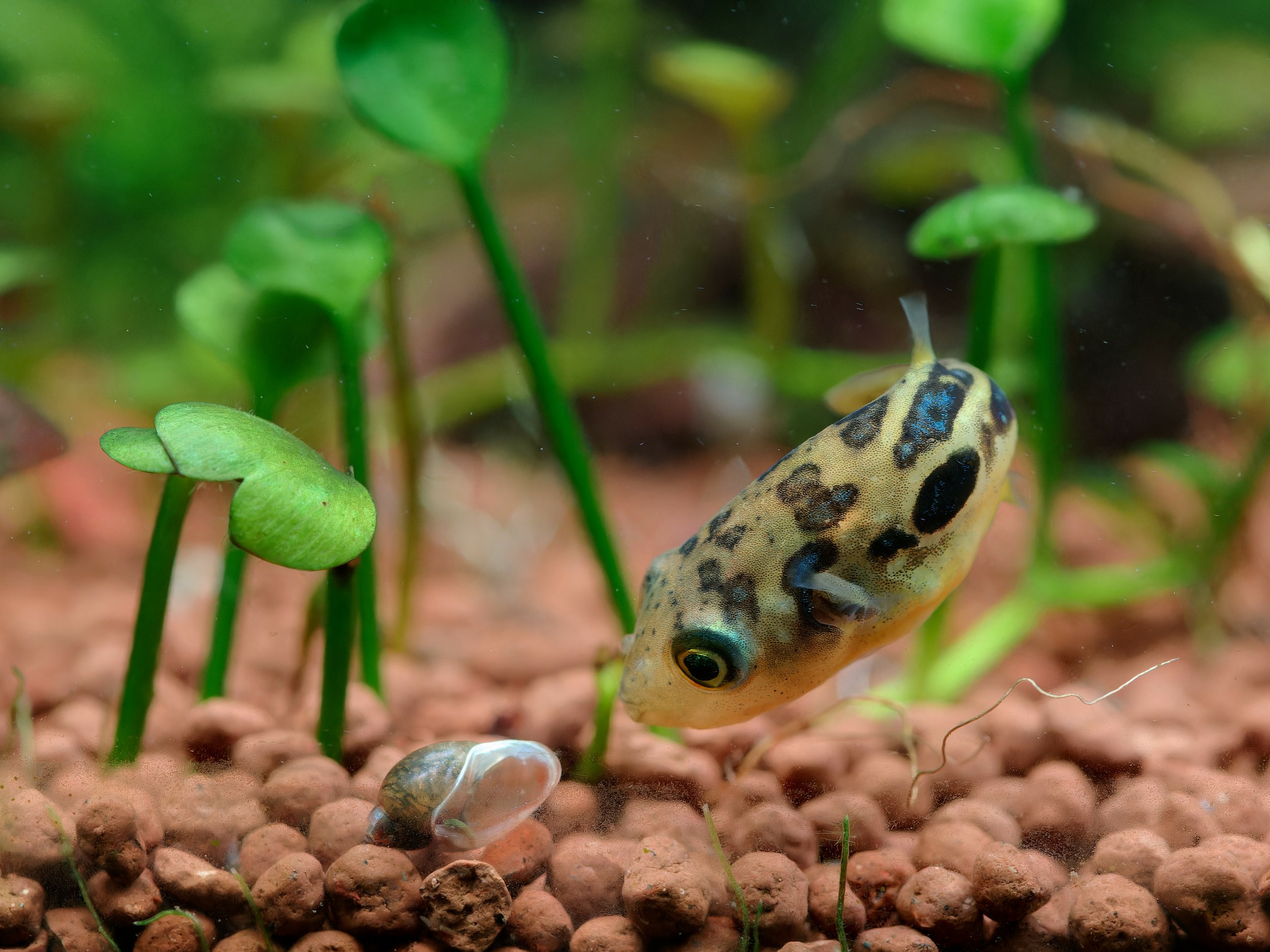Pea Puffer Care Guide: Everything You Need To Know
Pea pufferfish are fascinating, intelligent creatures that require specialized care to thrive. If you're seeking a captivating addition to your aquarium, look no further than these pint-sized predators. Here’s everything you need to know about the fascinating world of freshwater pea puffers, from their origins and care requirements to aquascapes and tankmate compatibility.
Discovering the Origins of Pea Puffers
Freshwater pea puffers belong to the species Carinotetraodon travancoricus, which is native to the freshwater habitats of South Asia, including India, Sri Lanka, and Bangladesh. In the wild, freshwater pea puffers inhabit slow-moving streams, rivers, and marshes, where they hunt for small invertebrates and crustaceans among dense vegetation and submerged debris. Pea puffers have captured the hearts of aquarists with their inquisitive nature and bold personalities. These tiny titans are known for their keen intelligence and predatory instincts, making them a captivating species to observe and care for.
Biology and Appearance
Freshwater pea puffers boast a charming appearance, with round, compact bodies and expressive eyes that seem to sparkle with curiosity. Their olive-green coloration and distinctive black markings add to their allure. Freshwater pea puffers are renowned for their playful and inquisitive nature, often interacting with their environment and tankmates in curious ways, such as chasing prey, exploring hiding places, and displaying courtship behaviors. With a maximum size of around 1 inch, these diminutive puffers are perfect for nano and species-specific tanks. Males typically develop bluish lines around their eyes and yellow bellies, while females retain their black spots from adolescence.
Tank Size and Water Parameters
When it comes to housing freshwater pea puffers, a tank size of at least 10 gallons is recommended to provide ample space for swimming and exploration. Maintain stable water parameters with temperatures ranging from 75-82°F, pH levels between 7.0-7.5, and moderate water flow. Regular water changes are crucial. Keep an eye on pH levels, particularly if black beard algae appear. A little algae is acceptable, as puffers may occasionally nibble on it. Soft, sandy substrate, hides and live plants are essential to replicate their natural habitat and minimize stress. If breeding is desired, ensure the tank includes a mop head or dense moss for egg-laying. Keep parent puffers well-fed to prevent predation on the eggs or fry.
Feeding Behavior
Live foods, such as blackworms, brine shrimp, and snails, are ideal. Frozen bloodworms, brine shrimp, and Beefheart are convenient alternatives if live food is hard to come by where you live. Pea puffers enjoy variety in their diet. In addition to regular meals, treat them occasionally with nutrient-rich options, such as a small portion of egg yolk or food soaked in garlic extract, which can also encourage picky eaters. We maintain a healthy population of bladder and ramshorn snails in our other tanks to provide a natural and nutritious snack to feed our pea puffers. Feeding pea puffers is a delight, as these voracious predators eagerly accept a varied diet of live and frozen foods. Offer diverse foods such as small snails, bloodworms, brine shrimp, and daphnia to stimulate natural hunting behaviors and ensure optimal nutrition and care. When feeding multiple puffers, use tongs to keep the food moving to minimize aggression over food sources.
Aquascape Aesthetics
A soft sand substrate is recommended, as pea puffers sometimes bury themselves when startled. Include live plants like Java ferns, Anubias, mosses, or fast-growing options such as Elodea, which help manage nitrates and ammonia while providing multiple hiding spots. Floating plants, dense moss patches, and driftwood are also beneficial. Though pea puffers are a shoaling species, they prefer to establish individual territories. Add enrichment items, such as hollow wood pieces or removable decorations, to keep their environment stimulating. Regular water changes are crucial. Keep an eye on pH levels, particularly if black beard algae appear. A little algae is acceptable, as puffers may occasionally nibble on it.
Tankmate Compatibility
While pea puffers can coexist with other species, avoid flashy or territorial fish, as well as those large enough to prey on the puffers. Amano and neocaridina shrimp make excellent tank mates due to their size and ability to clean leftover food and algae. Freshwater pea puffers are territorial and can be aggressive towards other fish and even their own kind, making them best suited for species-specific tanks or carefully curated communities of peaceful species. Avoid keeping them with long-finned or slow-moving tankmates, as they may harass or injure them. Choose tankmates wisely to ensure a harmonious aquarium environment.
Guarding Against Common Ailments
While freshwater pea puffers are generally hardy and resilient, they may be susceptible to common aquarium ailments such as bacterial infections, parasitic infestations, and fluctuations in water parameters. Keep a dewormer on hand, as pea puffers are prone to internal parasites, particularly wild-caught specimens. Regular observation for signs of worms or illness is essential. Monitor water parameters closely, perform regular maintenance, and quarantine new additions to minimize the risk of disease transmission within the tank.
Conclusion
Always inquire about the source of your pea puffers. Knowing whether they are tank-raised or wild-caught will help you adapt their care, particularly in terms of diet. Don't rush the selection process—choose healthy specimens with round bellies and vibrant coloration. When setting up their environment, focus on providing plenty of line-of-sight breaks and hiding spots to reduce territorial disputes.
Pea pufferfish are not beginner-friendly but can be incredibly rewarding for aquarists willing to meet their unique needs. With proper care and attention, these "little mafias" will thrive and delight their keeper with their charming personalities and curious behavior.
Pea Puffers Shopping List
